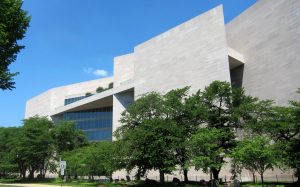One of the most famous artists of the past century, Jackson Pollock has long been a controversial figure for his simultaneously formless and evocative pieces. Pollock’s works are expressions of pure creativity, conveying his overwhelming urge to produce that simply required the immediate application of marks on canvas. The almost manic fury of Pollock’s works is apparent, and his compositions seem to jump from their canvases to splay themselves across the room with unmitigated energy. The 363 works from his 44 years chronicle an artist brimming with genius. On Nov. 19, the National Gallery of Art added Pollock’s “Mural” to their walls alongside six pieces by Pollock from its own collection, and devoted a small exhibition to the piece’s development and context.
“Mural” is impossible to miss as one enters the room, measuring nearly 20 feet long and filling an entire wall. Pollock’s patron, Peggy Guggenheim, gave him free reign with the piece, requesting only that it be a certain size. Gallery descriptions explain that Pollock had to remove one of the walls of his apartment in order to accommodate the piece, and that altogether he took the whole summer of 1943 to finish it. Though it hints at Pollock’s Action Painting technique, in which he laid the canvas on the ground and walked in and around it, “Mural” was painted upright in his studio.
The painting itself is deeply complex, depicting a varied scene that is at turns jubilant and natural, foreboding and industrial. Dark figures weave throughout the canvas, like dancers—arms raised and legs splayed in dynamic and explosive motion. The dancers appear to be in a forest packed with organic and exuberant chaos. Steely, industrial blue blazes through the piece, tying the massive canvas together but also drawing it away from a purely natural scene. As one spends more time with the work, however, the celebratory mood cedes to conflagratory fury, and the painting becomes a multicolored fire, knotted and roiling. The vastness and abstraction of the work allows the viewer’s imagination to run wild, identifying more figures the longer one looks at it, from a distorted face to an erect lizard to a somber bird.
“Mural” was a pivotal piece in the development of modern art, tying together both styles that preceded it and hinting at what was soon to come. Patches of canvas are visible behind light washes, punctuated by bold swatches of color bringing to mind Wassily Kandinsky’s “Improvisation 31 (Sea Battle)” from 1913. Similar technique was brought to its full potential in 1952, nine years after “Mural,” with Helen Frankenthaler’s massive “Mountains and Sea,” in which she “stained” her canvas with heavily diluted oil paints and interrupted these large patches of color with thick charcoal lines. In addition to being midway between Kandinsky and Frankenthaler’s approach to the color wash technique, “Mural” foreshadows the development of Pollock’s own renowned method—Action Painting. Throughout the canvas, splatters of varied color interrupt Pollock’s dynamic strokes, and bring an instinctual feeling to the work that would dominate his later pieces.
To its left hangs a smaller, but equally important work, Pollock’s “Lavender Mist.” The curator’s decision to place “Lavender Mist” alongside “Mural” highlights their similar styles, and draws attention to Pollock’s growth with Action Painting. Truly one of the artist’s masterpieces, Pollock painted “Lavender Mist” in 1950, seven years after “Mural.” It represents a significant development in the artist’s style, and elicits a varied cocktail of emotions as one delves into its textured and chaotic layering. The piece itself seems to be alive, humming and rippling with subversive energy, and while it contains only muted colors (and no lavender), it is irresistibly vibrant, boring into its audience’s retinas with shameless intentionality. A textbook example of Pollock’s Action Painting style, it treads in the gray area between technique, intuition, luck, and metaphysical inspiration. To create it, Pollock laid the canvas on his studio floor, diluted oil paints, and used brushes and mixing sticks to drizzle and splatter the canvas. He stepped on and across the work, allowing broken glass, cigarette butts, and errant flies to get caught in the drying paint. In places, “Lavender Mist” is rich and layered, and in others lightly-washed, allowing almost-bare canvas to peek through, a testament to Pollock’s free-form and unregulated style. The work feels like the encapsulation of Pollock’s era, a lynchpin for the artistic community. “Nothing is the same now,” it thunders. It is ominous, inexplicably heavy, and enchanting—and it knows so.
In “Number 7,” (1951) hanging to the right of “Mural,” Pollock abandons the texture of “Lavender Mist” and focuses on cultivating the work’s improvisational nature. Using a turkey baster, he dripped black paint onto the canvas, letting it soak in and spread through the fibers on its own. The result is bare and abstract, but more clearly representational than most of Pollock’s earlier works, depicting two figures pressed together in passionate embrace.
“Ritual” (1953) is a return to brushwork for Pollock, and again is ripe with energy. Its abstract forms leap ecstatically across the canvas, which is trisected by two thin black lines. The colorway is remarkably similar to that of “Mural,” tying the two pieces together in both technique and tone. Several untitled engravings and drawings from 1944-45 also hang in the room, and point to Pollock’s overwhelming creativity; no matter the medium, he churns out art brimming with orgastic verve.
Both “Mural” and “Lavender Mist” are masterpieces in their own right, but within the context of the National Gallery’s exhibit they show Pollock’s context and development. The exhibition, running until Oct. 28, 2018, provides a brief but clear view into one of the most influential artists of the 20th century, one who helped define and direct a genre that changed popular interpretations of art and its purpose.




